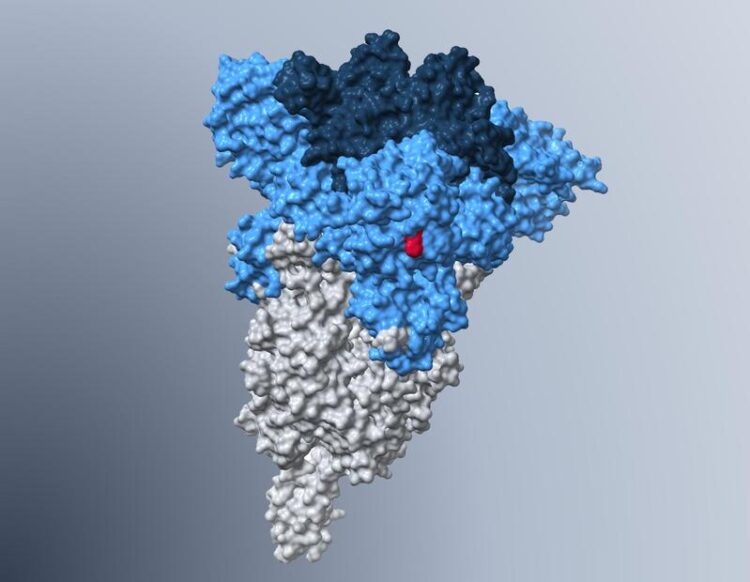Omicron subvariant BA.5 efficiently infects lung cells

Model of the spike protein of the Omicron subvariant BA.5, in which the H69Δ/V70Δ mutation that is partly responsible for the increased lung cell entry is highlighted in red.
Credit: Markus Hoffmann/DPZ Deutsches Primatenzentrum GmbH – Leibniz-Institut für Primatenforschung
Omicron variants are responsible for most COVID-19 infections worldwide. Compared to earlier virus variants, Omicron causes severe diseases less frequently.
However, an international team including scientists from the German Primate Center – Leibniz Institute for Primate Research has now identified a mutation in the spike protein of the Omicron subvariant BA.5 that enables the virus to efficiently infect lung cells again. The study shows that in the future, Omicron subvariants may emerge that could again effectively infect lung cells and thereby cause severe disease progression in humans with insufficient immunity.
Infection biologist Dr. Markus Hoffmann (left) and Prof. Dr. Stefan Pöhlmann, head of the Infection Biology Unit at the German Primate Center (DPZ) – Leibniz Institute for Primate Research. Karin Tilch/DPZ Deutsches Primatenzentrum GmbH – Leibniz-Institut für Primatenforschung
Omicron-derived virus variants are currently responsible for most SARS-CoV-2 infections worldwide. Compared to earlier virus variants, Omicron rarely causes severe disease. According to current knowledge, a major reason for this is that Omicron infects lung cells less efficiently and therefore causes pneumonia less frequently. However, an international team including scientists from the German Primate Center – Leibniz Institute for Primate Research, has now identified a mutation in the spike protein of the Omicron subvariant BA.5 that enables the virus to efficiently infect lung cells again. The study demonstrates that, over the course of evolution of Omicron subvariants, viruses may arise that regain the ability to effectively spread in the lung and cause severe illness in risk patients and people with insufficient immunity (Nature Communications).
Omicron subvariants
The BA.1 and BA.2 Omicron subvariants dominated the COVID-19 pandemic in the first half of 2022. Compared to previously circulating variants such as the Delta variant, these Omicron subvariants have in common that they cannot efficiently infect lung cells. Until now, it was unclear whether the Omicron subvariant BA.5, which displaced other Omicron subvariants in autumn 2022, has a similarly poor ability to infect lung cells. A team of scientists led by Markus Hoffmann and Stefan Pöhlmann from the German Primate Center has now shown that, due to a mutation of the spike protein, BA.5 actually infects lung cells much more efficiently than previous Omicron subvariants.
Mutation in the spike protein
The researchers found that the spike protein of the Omicron subvariant BA.5 is cleaved more efficiently than in earlier subvariants. Furthermore, the spike protein of BA.5 mediates entry of the virus into lung cells and fuses lung cells with higher efficiency. To investigate how the virus enters lung cells, the researchers used so-called “pseudo-viruses”, a safe model system of the real pathogen. Markus Hoffmann, first author of the study, explains: “We found that BA.5 has acquired a mutation that allows the virus to penetrate lung cells more efficiently than the previously dominant Omicron subvariants. Thus, the ongoing evolution of Omicron subvariants may produce viruses in the future that efficiently spread into the lower respiratory tract and may cause severe disease, at least in patients without effective immune protection.” The altered properties of Omicron BA.5 are due to a key mutation known as “H69Δ/V70Δ”.
Confirmation with the real virus
To confirm the results with real viruses, Christian Drosten’s team at the Virology Department of the Charité – Berlin University Hospital carried out further experiments. The researchers showed that real viruses of the BA.5 strain also infect lung cells efficiently, corroborating the results from Göttingen. To determine whether Omicron BA.5 also infects lung cells in living organisms, researchers at the University of Iowa in the USA compared the lungs of mice that were infected with BA.5 with those that received other subvariants. They found that BA.5 replicated up to 1000 times more efficiently in the lungs of mice compared to earlier Omicron subvariants. In addition, experiments with ferrets at the Friedrich-Loeffler-Institut in Greifswald – Insel Riems, Germany, revealed that the BA.5 subvariant spreads more efficiently in the upper respiratory tract than earlier virus variants. “All together, this suggests that similarly to other Omicron subvariants, BA.5 is highly contagious and has additionally evolved the ability to efficiently infect lung cells,” says Stefan Pöhlmann, head of the Infection Biology Unit at the German Primate Center. “The further evolution of Omicron subvariants should therefore be monitored closely in order to be able to quickly identify variants with increased risk potential.”
Wissenschaftliche Ansprechpartner:
Dr. Markus Hoffmann
Phone: +49 (0) 551 3851-338
Email: mhoffmann@dpz.eu
Prof. Dr. Pöhlmann
Phone: +49 551 3851-150
Email: spoehlmann@dpz.eu
Originalpublikation:
Original publication
Hoffmann M., Wong L. Y. R., Arora P. et al. Omicron subvariant BA.5 efficiently infects lung cells. Nature Communications 14: 3500 (2023). https://doi.org/10.1098/rsos.221225
Weitere Informationen:
https://www.dpz.eu/en/home/single-view/news/omikron-subvariante-ba5-infiziert-ef…
All latest news from the category: Life Sciences and Chemistry
Articles and reports from the Life Sciences and chemistry area deal with applied and basic research into modern biology, chemistry and human medicine.
Valuable information can be found on a range of life sciences fields including bacteriology, biochemistry, bionics, bioinformatics, biophysics, biotechnology, genetics, geobotany, human biology, marine biology, microbiology, molecular biology, cellular biology, zoology, bioinorganic chemistry, microchemistry and environmental chemistry.
Newest articles

Innovative 3D printed scaffolds offer new hope for bone healing
Researchers at the Institute for Bioengineering of Catalonia have developed novel 3D printed PLA-CaP scaffolds that promote blood vessel formation, ensuring better healing and regeneration of bone tissue. Bone is…

The surprising role of gut infection in Alzheimer’s disease
ASU- and Banner Alzheimer’s Institute-led study implicates link between a common virus and the disease, which travels from the gut to the brain and may be a target for antiviral…

Molecular gardening: New enzymes discovered for protein modification pruning
How deubiquitinases USP53 and USP54 cleave long polyubiquitin chains and how the former is linked to liver disease in children. Deubiquitinases (DUBs) are enzymes used by cells to trim protein…



